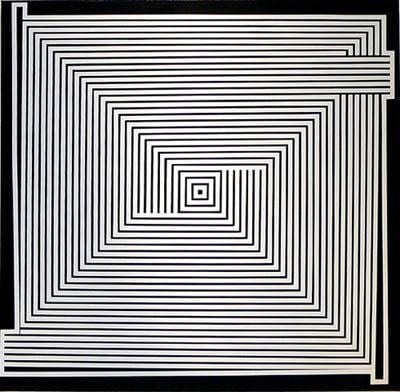Michael Schreiner’s paintings are loud, delightful collisions of bright colour. The gay Calgarian’s work is so enthralling and accomplished, it is difficult to believe he began painting just a few years ago, at the age of 60.
Clearly influenced by early-20th-century artistic movements like cubism, Schreiner is now unveiling his first major show, Leave a Message, at Calgary’s Weiss Gallery. “I called it Leave a Message because it conveys my belief that we all should — by the lives we lead and the things we do — leave a message of our existences,” he explains. “That’s the only eternity of life.” Schreiner began painting after working in various careers, including as a TV producer (he was head of the Alberta Access channel for 20 years) and restaurateur. Xtra caught up with the artist at his Calgary home on the eve of his exhibition’s opening.
Xtra: What would you say your major influences are?
Michael Schreiner: Kandinsky’s essays, when he talked about the inherent musicality of abstract art as well as the importance of vitality, have had a great impact on me. Whenever I am drawing a new piece, even after I have started painting, I am always seeking the energy and at times the contradictions within the lines and the flow of one area into another. I spend as much time simply watching the painting, contemplating where and how I will place the next “movement” as I do in the actual execution of the work. And almost without exception, the painting tells me where it has to go.
Xtra: I think your bold use of colour is one of the most striking things about your paintings.
MS: Hans Hofmann is my other guru, whose theory is that colour is figure, in that our remembrances of and connections to the physical world are inherently embodied in colour — a grey day, a blue sky, a red vase. Thus the physical object is identified by the colour; ergo, colour is the figure. He also talked about “colour field” painting, which I do. I use colours directly from the tube without any mixing of colour or over painting, emphasizing the flatness of the canvas. However, it is the graphic design of line and influence of one colour against another which gives the painting its depth, movement and tensions.
Xtra: You started painting while in your 60s. What brought you to painting?
MS: Being open to experience a new path and the serendipity of life, I suppose. I think aging changes one’s values of life and of expectations. I have become less interested in the physical world — for it is non-permanent — and more interested in the elements which lead to physicality, like creativity. What is the genesis of creativity, its essence, its expression. I thought that I would find it in acting but did not, in that my creativity was inherently tied to that of others. I wanted to explore it purely of myself, unhindered by any exterior expectation, formula or demand. But on a more practical, direct level, my painting began as a result of receiving a gift of an easel complete with paints from my sister. She bought it at Costco for $60.
Xtra: You have been painting for only a few years but you now have a show at a prominent gallery. You must be thrilled.
MS: I’m overwhelmed. A year ago I made the choice that I would devote all my energy and time to my art. I really have spent virtually all my time, starting at 4am — before work, late at night, the whole day when I could — committed to it. This, often despite an empty fridge, a messy house, neglected friendships, forgone sexual adventures, anxiety attacks — all to stay focused on painting and creating a sound, expressive and extensive body of work. But with that success come the inevitable doubts: Am I as good as others think? Do I still have that creative originality? Are there more canvases within me? To cope I have created two Michaels: there is the Michael of the kudos who exists in some life outside me. But the real Michael is the one who exists in my apartment, working on a new painting whose genesis is the colour of a bridge by Calatrava and Gershwin’s “Rhapsody in Blue.” There are always doubts and anxieties for an artist. You have to cope — that is the experience and the truth for an artist.

 Why you can trust Xtra
Why you can trust Xtra


